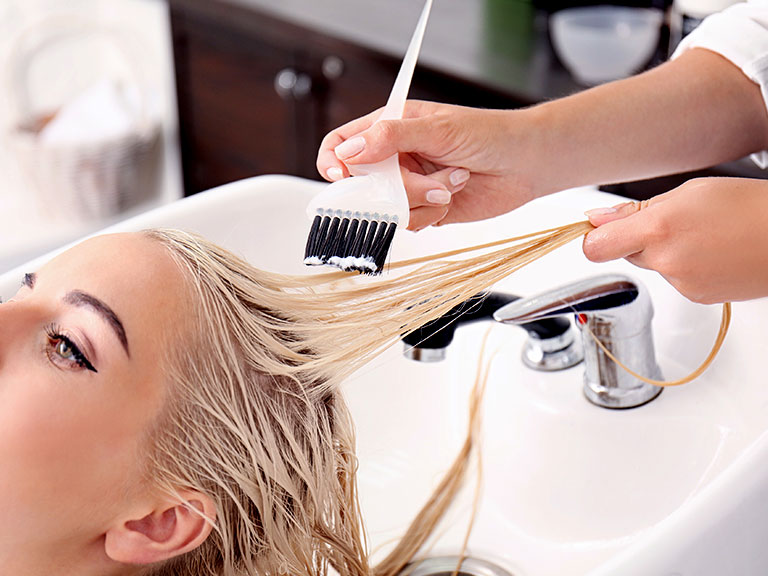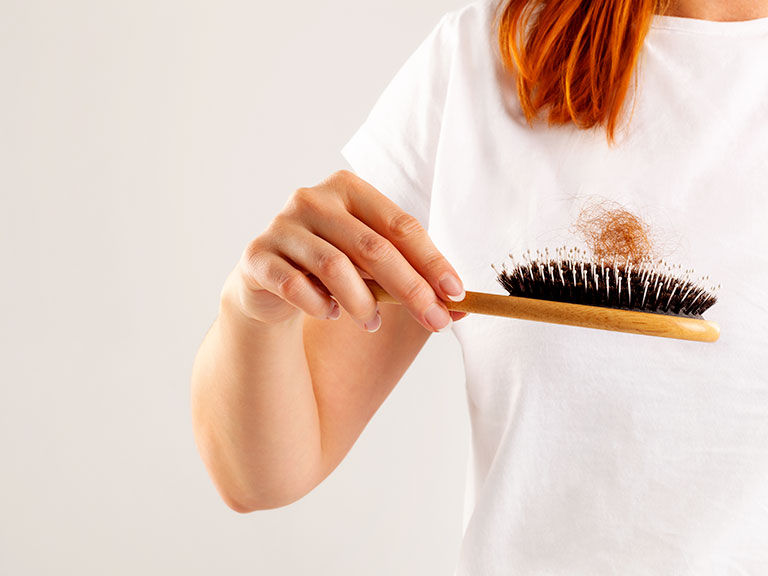A Guide to How Often to Have Hair Re-dyed at the Salon
In general, 4-6 weeks is the approximate time to wait before having hair colour reapplied. That being said, this isn’t a black and white timeline for hair colour reapplication. While leaving enough time between hair colour appointments helps minimize the risk of over-processing and damaging hair, your colourist will help determine the length of time needed between salon visits. If you’re hoping to fix or colour correct your hair, especially if it has been box dyed, you’ll definitely need some guidance from an experienced hair professional.
It seems that figuring out exactly how often to have your hair dyed is a delicate balance. Semi-permanent hair colours are the exception, since they can be used more often than permanent colours without risking damage.
These are just some of the reasons why we’ve written this guide with the help of several experienced hair colourists.
It’s time to clear-up your burning hair colour reapplication questions.
How Often to Colour Hair at the Salon
Since hair grows about ½ an inch per month, the standard 4-6 weeks between colour appointments seems ideal. If you don’t mind showing a bit of root grow-out and some colour fading, you can probably book colour sessions every 6-8 weeks depending on your colourists advice.
A key factor to how long you can stretch out appointments is your natural hair colour. Ask your colourist about a dropped root or root melt if you’re into longer stretches between salon visits. These are ideal for busy lifestyles or if you want an easy to maintain look while embracing your natural root colour.

Risks of Coloring Hair too Often
One thing we are sure of is that if you dye your hair too often, the dye can wreak havoc on your hair. It can mean long-term damage that is not easily repaired. Overdoing it can cause dry and brittle hair strands which are super prone to breakage. Split ends are another concern.
Especially if you are lightening your hair with bleach, damage is possible since your hair’s cortex is exposed during bleaching and permanent dye processes. Pro Tip: high-quality salon hair dyes and aftercare products are completely safe to use if they are not used too often and if they are applied by a professional colourist.
If, however, you choose to venture down the box-dye at home hair colour route, buyer beware. If you have been box dying your hair for years, who knows how many layers or colour are left behind on your hair. Your colourist may have a difficult time colour correcting or helping you achieve the colour of your dreams.
Types of Hair Dye
Although this article doesn’t cover each specific type of hair dye, here is a list of hair dyes. It’s definitely worth doing some digging to familiarize yourself with all the options out there. We’ll take an in-depth look at these in a future article.
- Temporary Hair Colour
- Semi-Permanent Hair Dye
- Demi-Permanent Hair Dye
- Permanent Hair Colour
- Highlights
- Ombré
- Balayage
- Lowlights
- Textured Highlights
- Root Colour
- Henna
- Hair Bleach

How Often to Re-dye Hair Based on Hair Types
Hair colour involves so much more than simply choosing your favourite colour and booking an appointment. There is so much to consider. The strength and integrity of your hair, your skin and hair’s natural colour, undertones, maintaining your colour at home between salon visits, and of course your budget.
Colouring hair is a labor of love that takes stylists years to perfect. Once you and your stylist find the perfect colours and techniques that work for you and your hair type, you’ll be able to achieve beautiful, luminous hair colours while maintaining the long-term health of your hair.
Regardless of your hair type and texture, remember that drastic changes take time and expertise. If your dream is to go from a brunette to platinum blonde, it will take several sessions. It’s also best to follow the “Rule of Two Shadesâ€. This means refraining from going more than 2 shades lighter or darker than your current hair colour.
Why is this an important rule to follow? Applying a hair colour that is too dark can lead to disasters like discolouration, uneven colour, and rapid colour fading. On the flip side, taking dark hair too light with just one colour session can also be disastrous. Pro Tip: Aim for gradual and subtle colour changes. You’ll achieve vibrant, rich and even colour tones that will last longer, keep your hair healthy, and make future hair appointments a breeze.
Keep your Hair Colour Lasting as Long as Possible
To help your hair colour last as long as possible, follow a few easy steps. Taking the time to learn about and implement these steps is well worth it.
- Skip hair wash days and opt for dry shampoo or a top knot
- Use a high-quality shampoo and conditioner
- Deep condition your hair regularly
- Avoid extremely hot showers
- Treat your hair with care and respect
How to Maintain Colour-Treated Hair
- After having hair coloured, wait 72 hours before shampooing
- Always use a sulfate-free shampoo and conditioner, preferably one designed for colour-treated hair
- Use dry shampoo to extend wash days
- Use leave-in treatments to protect hair colour when styling
- Apply a heat protectant when using heat styling tools
Does Hair Dye Lighten a Few Days after Application?
Definitely. Hair dyes tend to lighten a few days after they have been applied. As the dye settles into hair fibres, which takes about 3 to 4 days, it begins to lighten to the intended colour. Also, any pigments that your hair doesn’t absorb washes away with each shampoo and thus slightly fades the colour.
Hair Loss and Damage after Colour Application
While some people embrace their natural hair colour, others choose to dye it – but can hair dyes cause hair loss? Sometimes, after hair is dyed you may experience some hair fall. This is completely normal. During a dying procedure, hair shafts are manipulated and tend to swell.
Luckily, after hair dye has been applied, hair shafts can be closed once again with your stylist’s use of after-colour products. Many of these products have been developed specifically to lock in hair colour and keep it shiny and vibrant between colour appointments.
Some of these products are best used right after colour application. They help stop the oxidative process and restore the pH balance of hair. Your stylist will also recommend at-home hair colour aftercare products which are designed to keep hair cuticles healthy and protect hair from all kinds of environmental factors that can affect the long-term vibrancy of your colour.
Keep in mind that once you’ve dyed your hair, it will remain more porous than virgin hair.

Types of Hair Colour Treatments
Post-Colour Treatments: used right after hair colour to complete a colour service. Applied by your colourist while your hair is still wet after hair dye is rinsed. Post-colour sealers close hair cuticles to help lock in colour, untangle knots, and keep coloured hair soft and shiny. Pro Tip: after-colour treatments are especially beneficial for highly porous hair and on colours that tend to fade fast like shades of red and fashion colours.
Hair Glaze: this treatment is used to seal hair cuticles after colour application to reveal a deeper, more intense colour. Essentially, a glaze coats hair shafts, enhances permanent colours and helps extend how long a hair colour will last.
Hair Gloss: glossing is a salon treatment meant to lock in hair colours and add an intense shine. A gloss coats hair without penetrating the shafts, and also smooths and tightens cuticles. Glosses also create a shiny barrier around hair shafts and revitalize dull colour. They slowly wash out with each shampoo, so having it reapplied every 4-6 weeks will keep your colour looking fresh. Tip: ask your stylist about tinted hair glosses which deposit small amounts of colour and preserve your colour between salon visits.
Colour Lock Hair Masks: designed to repair damaged hair or weakened hair cuticles. These hair masks help hold colour molecules inside hair and extend colour vibrancy. Colour hair masks can also increase hair’s strength and elasticity, while softening hair that has been damaged due to colouring.
Leave-in Colour Lock Products: designed to seal hair cuticles, preserve colour and prevent colour from washing out prematurely. Ingredients include amino acids, nourishing oils, antioxidants, and sunscreen. They also help tame frizz, moisturizer hair and improve hair’s softness and manageability.
How often to Re-Dye Grey Hair
Just as with other hair colours, every 4-6 weeks is the recommended timeframe between colour appointments. If you dye grey hair a permanent colour, you’ll have regrowth in about 4-6 weeks, whereas if you opt for a semi-permanent colour, it will have mostly faded in 6 to 8 weeks. You won’t have a regrowth line, so you’ll be able to start fresh with a colour.
Visit Beautster.com and easily book your next colour appointment with an experienced colourist near you!